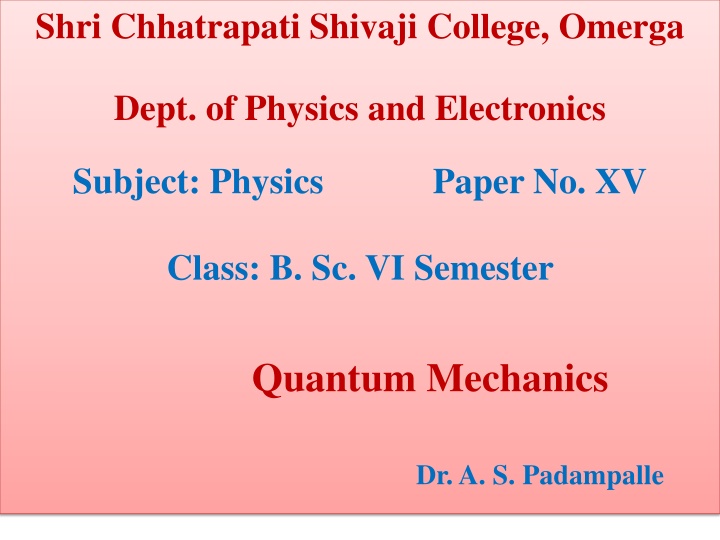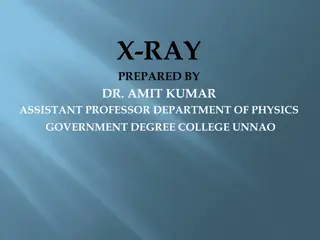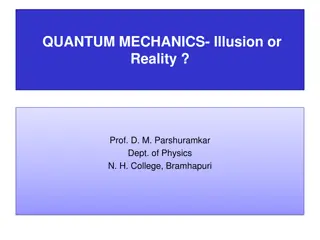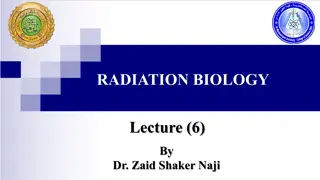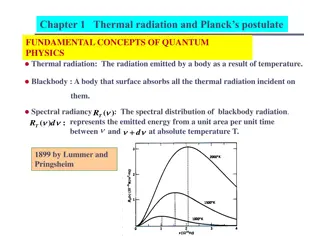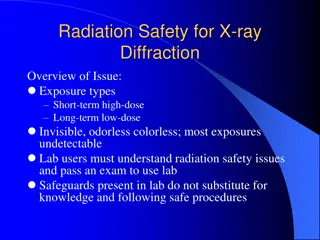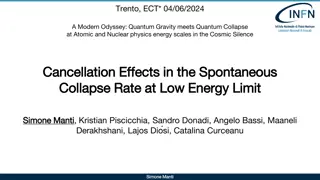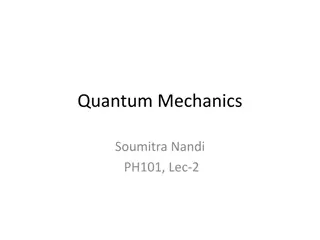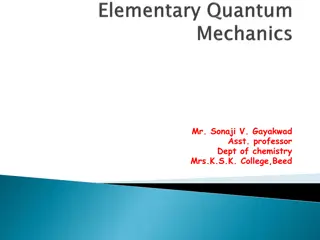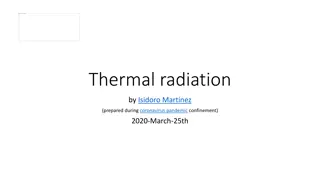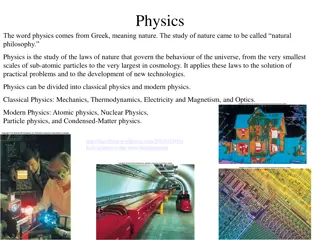Unveiling the Quantum World: Understanding Blackbody Radiation and Quantum Mechanics
Quantum Mechanics emerged between 1900 and 1930 as a revolutionary theory explaining the behavior of microscopic particles. This article delves into the need for Quantum Physics due to classical mechanics' limitations, focusing on Blackbody Radiation and laws governing it like Wiens Displacement Law, Wiens Radiation Law, Raleigh-Jeans Law, and Planck's Quantum Theory. The concept of a perfect black body, energy distribution, and quantum numbers are explored, shedding light on the fascinating realm of Quantum Physics.
Download Presentation

Please find below an Image/Link to download the presentation.
The content on the website is provided AS IS for your information and personal use only. It may not be sold, licensed, or shared on other websites without obtaining consent from the author.If you encounter any issues during the download, it is possible that the publisher has removed the file from their server.
You are allowed to download the files provided on this website for personal or commercial use, subject to the condition that they are used lawfully. All files are the property of their respective owners.
The content on the website is provided AS IS for your information and personal use only. It may not be sold, licensed, or shared on other websites without obtaining consent from the author.
E N D
Presentation Transcript
Shri Chhatrapati Shivaji College, Omerga Dept. of Physics and Electronics Subject: Physics Paper No. XV Class: B. Sc. VI Semester Quantum Mechanics Dr. A. S. Padampalle
Need for Quantum Physics Problems remained from classical mechanics that the special theory of relativity didn t explain. Attempts to apply the laws of classical physics to explain the behavior of matter on the atomic scale were consistently unsuccessful. Problems included: Blackbody radiation The electromagnetic radiation emitted by a heated object Photoelectric effect Emission of electrons by an illuminated metal Quantum Mechanics Revolution Between 1900 and 1930, another revolution took place in physics. A new theory called quantum mechanics was successful in explaining the behavior of particles of microscopic size. The first explanation using quantum theory was introduced by Max Planck. Many other physicists were involved in other subsequent developments
Black body: A perfect black body is one which absorbs all the radiation of heat falling on it and emits all the radiation when heated in an isothermal enclosure. The heat radiation emitted by the black body is called black body radiation. Laws of Black body radiation: 1) Wien s displacement law: This law states that the product of the maximum wavelength ( m) corresponding to the maximum energy and the absolute temperature is a constant. i.e. when the temperature increases the wavelength corresponding to the maximum energy decreases.
Wiens radiation law: The maximum energy radiated at peak wavelength is directly proportional to the fifth power of the absolute temperature (T5).
Raleigh Jeans Law: This law states that the energy distribution is directly proportional to absolute temperature (T) and inversely proportional to the fourth power of wavelength ( 4). Limitation: This law holds well only for the longer wavelength and not for the shorter wavelength.
Plancks quantum theory of black body radiation: Planck s theory: A black body contains a large number of oscillating particles: Each particle is vibrating with a characteristic frequency. The frequency of radiation emitted by the oscillator is the same as the oscillator frequency. The oscillator can absorb energy in multiples of small unit called quantum. This quantum of radiation is called photon. The energy of a photon is directly proportional to the frequency of radiation emitted. E or E=h An oscillator vibrating with frequency can only emit energy in integral multiples of h . ?n= nh , where n= 1, 2, 3, 4 .n. n is called quantum number.
Planck law of radiation: The energy density of radiations emitted by a black body at a temperature T in the wavelength range to +d is given by
Derivation of Plancks law: Consider a black body with a large number of atomic oscillators. Average energy per oscillator is = E/N (1) Where E is the total energy of all the oscillators and N is the number of oscillators. Let the number of oscillators in ground state is be N0. According to Maxwell s law of distribution, the number of oscillators having an energy value EN is given by Where T is the absolute temperature. K is the Boltzmann constant. Let N0 be the number of oscillators having energy E0, N1 be the number of oscillators having energy E1, N2 be the number of oscillators having energy E2 and so on.
Then From Planck s theory, E can take only integral values of h . Hence the possible energy are 0, h , 2 h ,3 h . and so on.
The number of oscillators per unit volume in the wavelength range and +d is given by Hence the energy density of radiation between the wavelength range and +d is E d = No. of oscillator per unit volume in the range and +d X Average energy.
The equation (16) represents Plancks law of radiation. Planck s law can also be represented in terms of frequencies.
Deductions of Radiation laws from Plancks Law: I. Wien s Law:
II. Raleigh- Jeans law: Thus Planck s law reduces to Raleigh- jean s law at longer wavelength.
Matter Waves De Broglie s Hypothesis: 1. Waves and particles are the modes of energy propagation. 2. Universe of composed of matter and radiations. 3. Since matter loves symmetry matter and waves must be symmetric. 4. If radiation like light which is a wave can act like particle some time, then materials like particles can also act like wave some time. De Broglie waves and wavelength:
Therefore, Where p = mv is the momentum of the particle of mass m and velocity V. De Broglie wavelength in terms of energy We know that Kinetic energy Multiplying by m on both sides
Eqn(7) represent De Broglies wavelength in terms of energy. Let q be charge and V be potential on charged particle then, Kinetic energy of particle is E = qV . De Broglie wavelength is
Schrodinger wave equation Schrodinger equation is basic equation of matter waves. The two forms of the wave equation are: 1. Time independent wave equation 2. Time dependent wave equation 1. Schrodinger time independent equation:
If E is the energy of the particle and V is the potential energy and mv2 is the kinetic energy, then Total energy (E)= potential energy (V) + kinetic energy ( mv2).
II. Schrodinger time dependent equation: Consider a wave associated with a particle. Let x, y, z be the coordinates of the particle. Let be the displacement for the de Broglie wave at any time,
